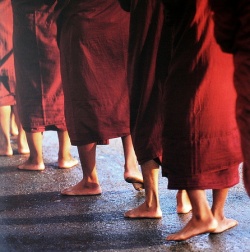Sphutartha
Jump to navigation
Jump to search
Clear Meaning Commentary (Skt. Sphuṭārthā; Wyl. 'grel pa don gsal) by Haribhadra, the most celebrated commentary on Maitreya's Abhisamayalankara.
The actual title is 'Commentary on the Abhisamayalankara, the Shastra of Instructions on the Prajnaparamita' (Skt. Abhisamayālaṅkāra-nāma-prajñāpāramitopadeśaśāstravṛtti; Wyl. shes rab kyi pha rol tu phyin pa'i man ngag gi bstan bcos mngon par rtogs pa'i rgyan zhes bya ba'i 'grel pa), but it is commonly known as the Sphutartha (literally 'blossomed or burst open meaning').
Commentaries
Indian
- Dharmamitra, Explanatory Commentary Clarifying the Words
- Serlingpa, Light on the Difficult-to-Comprehend
- Prajñakaramati, Essential Meaning
Tibetan
- Yaktön Sangye Pal, Yak-tik or mngon rtogs rgyan 'grel pa rin chen bsam 'phel dbang rgyal
- Khenpo Shenga, Shenpen Nangwa
Further Reading
- Hirofusa Amano, A Fragment from the Abhisamayālaṅkāra-namaprajñaparamitopadesa-sastravṛtti, alias 'Sphuṭartha' of Haribhadra, Annual Report of the Tôhoku Research Institute of Buddhist Culture, vol. 3 (1961), pp. 1-25 (in Japanese).
- Hirofusa Amano, A Study on the Abhisamaya-Alaṅkara-Karika-Sastra-Vṛtti (Tokyo 1975) 314 pp., Sanskrit and Tibetan. Reviewed by J.W. de Jong in Indo-Iranian Journal, vol. 20 (1978), pp. 313-314.
- K.H. Amano, On the Composite Purpose of the Abhisamayālaṅkāra-karika-sastra. Haribhadra's Way of Explaining, Journal of Indian and Buddhist Studies, vol. 17, no. 2 (1969), pp. 59-69 (in Japanese).
- Hirofusa Amano, Sanskrit Manuscript of the Abhisamayalaṅkara-vṛtti. In six parts: Bulletin of the Hijiyama Women's Junior College, vol. 7 (1983), pp. 1-15. Bulletin of the Faculty of Education of Shimane University, vol. 19 (1985), pp. 124-138; 20 (1986), pp. 67-86; 21 (1987), pp. 39-51; 22 (1988), pp. 10-25; 23 (1989), pp. 1-7.
- David P. Jackson, ed., Rong-ston on the Prajñāpāramitā Philosophy of the Abhisamayālaṃkāra, His Sub-commentary on Haribhadra's "Sphuṭārthā": A Facsimile Reproduction of the Earliest Known Blockprint Edition, from an Exemplar Preserved in the Tibet House, New Delhi, Nagata Bunshodo (Kyoto 1988)

